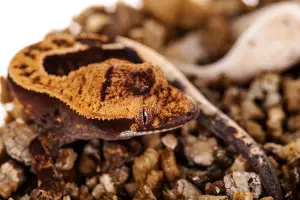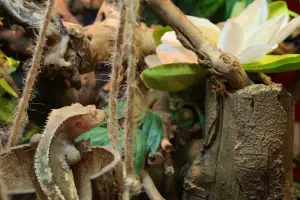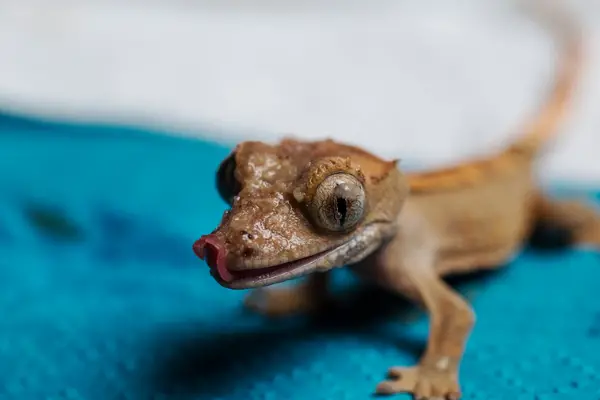First-time gecko owners usually choose to get an adult crested gecko or a juvenile approaching adulthood since they are much easier to take care of.
However, if you’re more experienced, there’s no reason why you couldn’t get a baby crested gecko.
It is easier to bond with a baby crested gecko and you will learn so much as you see him grow through every stage: hatching to juvenile to adult.
When you have a baby crested gecko, you need special housing and you need to take extra special care of the environment.
Hatchlings and juveniles need high humidity so that they can shed their skin. They also need a careful diet so that they can grow well and become healthy as adults.
Caring for baby crested geckos isn’t too difficult but you will need to handle them more delicately when they’re so small.
In this article, when we talk of baby crested geckos, we’re referring to both hatchlings and juveniles. Crested geckos become adults at around 18 months old.
We consider them to be babies until around 6 months, after which they’re juveniles.
I will also list the items that you will need to buy to be able to care for your baby crested gecko.
Baby crested geckos – hatchlings- Size and weight.
Crested Gecko Babies hatch at around 2 or 3 months. At this stage, the baby crested gecko is still small and will be between 6 and 7.4 centimetres in length, weighing about 2 grams.
Their weight and size will vary depending on their genetics as well as the temperature of their incubation.
It’s important to check your baby crested gecko’s growth. You should weigh him every week – your kitchen scales are the best thing to use.
For each month, you should expect your crested gecko to grow heavier by about one gram. By about six months of age, your baby crestie should weigh around 9 grams.
If you would like to know more about the sizes and lifespan of a crested gecko check out the guide I wrote on it.
Is it easy to care for a baby crested gecko?
Baby crested geckos only need slightly different care than adult Crested Geckos. They need to be misted twice per day and you shouldn’t overhandle them.
You should always give them time to get used to their new surroundings and acclimatise before beginning to handle them routinely.
Your baby will need between one and two weeks to get used to their enclosure before you should touch them routinely.
You should keep an eye on them to ensure they are shedding properly.
Lots of baby crested geckos will be happier if they are in a small terrarium, to begin with. Similar to adults, baby crested geckos need the humidity to be 50-80%. The terrarium should have a temperature between 22° and 26°C (72-78°F) during the day and 20° and 23°C (69-74°F) at night time.
There should be some artificial light or indirect sunlight for around 12 to 14 hours a day and there doesn’t need to be any lighting at night time.
Advice suggests not handling your baby crested gecko until he is over six months old unless you are weighing him or cleaning out his enclosure.
Whenever you do handle him, make sure you are really careful. Never grab his tail as this can lead to tail loss or stress.
Are baby crested geckos friendly?
Your baby gecko will naturally come across as skittish. It’s very normal for them to appear unfriendly until they have got used to you and their surroundings and unfortunately for you, this can take a while.
How should you go about handling a baby crested gecko?
Until your baby crested gecko reaches a length of around three inches, you can cause injury when handling.
It’s always better to wait until they are bigger than this before you routinely handle them.
What’s more, whenever you move them to a new enclosure, you need to avoid handling them for two weeks while they are adjusting.
After this, you can handle them for between 5 and 15 minutes per day to allow them to get used to you holding them without being stressed.
You also need to remember that reptiles absorb things like toxic chemicals, germs, and bacteria through their skin.
This means that anyone who handles your baby gecko must do so with freshly washed hands.
In addition to this, you will also need to make sure you wash your hands after touching your pet as reptiles are known to carry bacteria and other disease-causing substances.
Baby Crested Gecko tail loss.
One final important point about handling is to remember that you should never handle your crested gecko by its tail. Crested geckos will naturally release or “drop” their tails to help them escape when grabbed by a predator.
Because of this, you should not handle their tail as their instincts might make them react as though you are a predator. If your crested gecko does lose its tail, it is possible for it to grow back.
However, the area of breakage is susceptible to disease and infection. Any new tail grown could look very different in terms of shape and colour compared to its original, too.
Therefore, whenever you are handling your baby crested gecko, make sure you use a flat hand. You should use your other hand to help prevent him from running away or jumping.
You can encourage young geckos to get used to being handled by using “hand walking.” This is when you sit your gecko on one hand and offer the palm of your other hand in the front.
This encourages the crested gecko to move forwards or hop onto your second hand. Repeating this movement is a fun way for your pet to get used to you.
Do baby crested geckos bite?
All crested geckos might bite if they feel threatened.
And because baby crested geckos are less confident and sure of their surroundings, they are more likely to bite than adults.
That said, biting is still quite rare and crested geckos are known as being a calm and docile species, especially in adulthood.
Occasionally, biting might be a sign that your crested gecko is being handled too often or too much. So if you have been increasing the amount you are handling your pet, you might want to cut back a little.
Another reason your baby crested gecko might bite is if he mistakes your finger for food!

Do baby crested geckos fire up and down like adult crested geckos?
Do baby crested geckos change colour (fire up?)
Crested geckos do change colour and a colour change can simply be put down to ageing.
Hatchlings and juvenile crested geckos will typically have a different shade or colour to the colour they end up as, as adults. You can’t determine the colour your crested gecko will end up until he is around 12 months old.
The colour of the adult can be very different to the hatchling colour he was born with. Also, hatchlings rarely have any patterns or marks. These also develop with age.
As to whether or not they “fire up,” this depends on a few things.
Crested geckos are unable to change colour at will and any colour change happens due to ageing or other triggers in their environment.
The shed cycle can also affect the colour of your crested gecko temporarily. A crested gecko “firing up” depends on various factors. Owners can influence this. The most common reasons why your crested gecko might fire up are:
- High temperature – your crested gecko might fire up with temperatures above 26 or 27°C (80°F).
- High humidity – if the humidity is above 70%, your crested gecko might “fire up.”
- Lights (or lack thereof) – crested geckos often fire up overnight when the light is low. This could be so that they are more invisible to predators because they’re darker.
- Activity – when asleep, your crested gecko will typically be “fired down” and duller in colour. When active, he will usually “fire up” and become darker.
Firing up can also happen due to the mood of your crested gecko. Fear and stress can be a cause.
Your crestie might feel stress or fear if he has been put into a new environment, if his living conditions are overcrowded or poor, if he is being handled inappropriately or too much, or even if it’s breeding season.
How should you set up a terrarium for a baby crested gecko?
For a baby, you need to think of your enclosure, the plants, and the substrate.
You should try to include some branches or plants but your baby won’t need lots of climbing opportunities when he is young.
For a baby, start small. As he grows, you can try increasing the size of his enclosure but you should do this gradually to reduce stress.
The substrate for babies
Because of their smaller size, you can’t use the same substrate for your baby crested gecko that you would use for an adult.
Baby crested geckos need a substrate that has a low risk of ingestion. It should also be easy to clean. With this in mind, you don’t actually have that many options! With this in mind, you should consider the following:
- Don’t use a substrate. If you don’t have a substrate in your baby crested gecko’s terrarium, he can’t ingest it. However, not having a substrate has its risks too. Since baby crested geckos need high humidity, there will be a build-up of water on the terrarium’s surface. Without a substrate, bacteria will increase. This means you will have to clean the terrarium daily.
- The most popular choice for baby crested geckos is to use a paper substrate. This is a safe idea as a first substrate and it’s also cheap! You don’t have to buy anything special, paper towels or old newspapers will be fine. If you notice your hatchling tries to tear up or eat the paper, you should buy butcher paper as it is much more robust and won’t tear as easily.
For older juveniles (6 months +), you can have a more naturalistic substrate. However, in an ideal world, make sure your crested gecko is into adulthood before you use a substrate that has an associated risk of ingestion.
This will minimise the risk of impaction.
Branches and plants in the terrarium
Plants are a great way of proving hiding places and climbing opportunities for your baby crested gecko.
Live plants are good for increasing humidity and to give your terrarium a more natural look. That said, baby cresties will benefit more from pretend vines.
Their small container is also not the best place for live plants to grow.
Think about including a couple of small branches and some fake vines or plants so that your baby crested gecko has some hiding places.
You should try to get 50% of the enclosure free from any foliage, just like you would with an adult crested gecko.
Buying guide for a baby Crested Gecko.
It is so important when caring for a baby Crested Gecko that you provide it with all of the necessary equipment that it needs to grow and thrive in captivity.
Below is a list of some of the products that I recommend you buy from the correct terrarium to tank furniture and thermometers.
The best terrarium to buy for a baby crested gecko.

You need to make sure that you buy the right terrarium for your baby crested gecko.
It is so important that you do not scare your baby crested gecko by placing it in a terrarium that is far to large. On the flip side you do not want to have to replace the terrarium after a couple of months as they are expensive for a quality one.
That is why I recommend that you buy one such as this Exo Terra terrarium over on Amazon.
As you can see it is the perfect size, quality and shape for a Crested Gecko. A vertical terrarium is essential as crested geckos are great climbers.
Terrarium furniture
Now that you have your perfect terrarium for your baby crested gecko it is time to furnish it.
Furnishing the terrarium offers a bit of privacy for your little friend and helps to mimic its natural environment.
I find it is best to buy specially made branches, foliage and rock caves from Amazon. They are fairly cheap and inexpensive and are of good solid quality.
Take a look at this terrarium furniture on Amazon for some inspiration.
Buy a decent thermometer and humidity gauge.
One of the most important parts of baby crested gecko ownership is making sure that your pet has the correct temperature and humidity in its terrarium.
If this is not set right your crested gecko may struggle with shedding and also will not be able to get the energy that it needs from the heat.
That is why it is very important to buy a good thermometer and humidity gauge.
I recommend buying this temperature and humidity gauge from Amazon, it is fairly cheap but good quality and accurate!
What do baby crested geckos eat?
For the first few days of a baby crested gecko’s life, he will be able to sustain himself on the yolk sack. Don’t be alarmed if your hatchling doesn’t eat for the first few days after hatching.
Babies typically eat after they have shed for the first time. This happens between two and three days after they have hatched.
You should put some food in your crested gecko’s enclosure one to two days after he has hatched to make sure he has food for when he is ready.
Crested geckos have an omnivorous diet. You should begin by only feeding your baby commercial crested gecko food. This way, you will know that your pet is getting all of the nutrients he needs to grow into a healthy adult.
Can you feed insects to a baby crested gecko?
A baby crested gecko can eat insects. They should be dusted with D3 and calcium powder and be gut-loaded. You can feed a baby crested gecko two crickets every 48h but if you should be wary of doing this if you are providing a commercial diet.
How much water does a baby crested gecko need?
While your baby crested gecko will need water, he will only usually drink the water droplets that are present after misting.
Nevertheless, you should put a bowl of water in your pet’s container regardless. This should be shallow enough so as to prevent possible drowning.
Do baby crested geckos get sick?
This is an important question for all new and would-be baby crested gecko owners.
Too many owners don’t read up enough on what raising a baby crested gecko entails. Many are not aware, for example, that they need to provide gut-loaded insects or ones that are dusted with supplements.
This means that many baby geckos (especially those in indoor enclosures lacking in UV light) develop metabolic bone disease due to a lack of calcium and vitamin D.
If baby crested geckos don’t have enough Vitamin D and calcium, their bones won’t be able to ossify and will remain spongy and soft. This means that they might fracture or fold.
If this happens, a crested gecko can stop eating and moving and become weak. Eventually, these animals will die if they don’t receive treatment.
If you see signs that your crested gecko seems weak, you should bring him to a vet as soon as you can. With early treatment with Vitamin D and calcium, your crested gecko will be able to make a complete recovery.
Accidental consumption of sand
Another common disease for baby geckos is obstruction and impaction. This is a life-threatening gastrointestinal condition meaning that the crested gecko has consumed small amounts of sand when they have eaten insects.
This gradually builds up in their body and ends up obstructing their GI tract. If this is happening to your crested gecko, you will notice him becoming weak, stopping eating, straining when trying to pass stool, and eventually, he will stop being able to pass stool at all.
If you see any of these signs, you should seek advice from your vet. If this is happening to your crested gecko, there is an effective treatment in the form of oral laxatives, enemas, and subcutaneous fluids.
Skin retention
A final illness that baby crested geckos can get is skin retention.
Skin retention occurs when your crested gecko attempts to shed but the humidity isn’t high enough.
When humidity is too low, crested geckos retain skin patches around their eyes and toes. This can make them blind or lose their toes, respectively.
When this happens, you might notice your crested gecko refrain from eating or lose weight. Unfortunately, crested geckos can die from this too.
If you do notice that your crested gecko hasn’t been able to shed properly, you should seek medical advice from your vet. They will be able to rehydrate your crested gecko and give him food until he recovers.
Final thoughts
Caring for a baby crested gecko is best left to people who have experience raising adults.
While it’s not too challenging to raise a crested gecko from being a hatchling, you do need time and patience. It’s important never to go out and purchase a baby crested gecko on a whim.
Firstly, you need to do some research so that you know what enclosure, substrate, plants, and food to buy. Secondly, you need to read up about how to raise the crested gecko so that you don’t overhandle him and instil fear.
Finally, you should be aware of any potential illnesses that baby crested geckos are susceptible to and, if you have any doubts, seek advice from your veterinarian.
